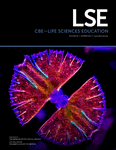Race and Gender Differences in Undergraduate Research Mentoring Structures and Research Outcomes
Abstract
Participating in undergraduate research with mentorship from faculty may be particularly important for ensuring the persistence of women and minority students in science. Yet many life science undergraduates at research universities are mentored by graduate or postdoctoral researchers (i.e., postgraduates). We surveyed a national sample of undergraduate life science researchers about the mentoring structure of their research experiences and the outcomes they realized from participating in research. We observed two common mentoring structures: an open triad with undergraduate–postgraduate and postgraduate–faculty ties but no undergraduate–faculty tie, and a closed triad with ties among all three members. We found that men and underrepresented minority (URM) students are significantly more likely to report a direct tie to their faculty mentors (closed triad) than women, white, and Asian students. We also determined that mentoring structure was associated with differences in student outcomes. Women’s mentoring structures were associated with their lower scientific identity, lower intentions to pursue a science, technology, engineering, and mathematics (STEM) PhD, and lower scholarly productivity. URM students’ mentoring structures were associated with higher scientific identity, greater intentions to pursue a STEM PhD, and higher scholarly productivity. Asian students reported lower scientific identity and intentions to pursue a STEM PhD, which were unrelated to their mentoring structures.



